inventor
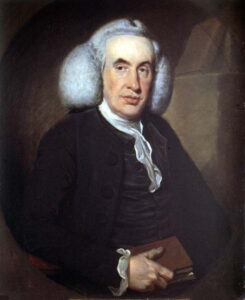 Most people, these days, don’t necessarily know who William Cullen is, but historically speaking, he is a very important man. Born April 15, 1710, in Hamilton, Lanarkshire, the son of William Cullen…a lawyer and Elizabeth Roberton of Whistlebury. Cullen was a Scottish physician, chemist and agriculturalist, as well as a professor at the Edinburgh Medical School, but these things would not be the defining accomplishment of his life. Cullen saw a need for something, that many people knew they needed, but no one knew how to get it.
Most people, these days, don’t necessarily know who William Cullen is, but historically speaking, he is a very important man. Born April 15, 1710, in Hamilton, Lanarkshire, the son of William Cullen…a lawyer and Elizabeth Roberton of Whistlebury. Cullen was a Scottish physician, chemist and agriculturalist, as well as a professor at the Edinburgh Medical School, but these things would not be the defining accomplishment of his life. Cullen saw a need for something, that many people knew they needed, but no one knew how to get it.
Years ago, towns had an icehouse. Snow and ice were stored in a cellar in an effort to keep them frozen for use by the townspeople. Then the icehouse owner would bring ice to people, and it would basically be kept in a “cooler” so food could be kept cold for a while. It was an imperfect system, but it was all they had. Cullen could see that something better was needed. I’m sure he saw the diseases that came from spoiled food and maybe even deaths from that food. That got him thinking.
After Cullen completed his education at the University of Glasgow and the University of Edinburgh, he started his formal career. His field of study and subsequent career in medicine and after completing the studies, he started in that career, but he was also interested in working on a scientific basis to invent different things. That was when Cullen envisioned and then invented an artificial refrigerator which was used manually to save many things from getting wasted.
These days, the refrigerator is an appliance which can be found in almost every house, and it is one of the most used appliances. It comes in different shapes and in different sizes. Normally, it is made up in “the form of two compartments and one of them is insulated thermally, while the other compartment consists of a heat pump and its important function is the transfer of heat. This transfer is done to manage heat environment.” I don’t presume to understand how all that works. I just know that my food stays the temperature it needs to be to either freeze it of just keep it cold.
In 1741 he married Anne (or Anna) Johnstone, who died 1786. He was father to Robert Cullen and Henry Cullen, who became a physician. Cullen’s eldest son Robert became a Scottish judge in 1796 under the title of Lord Cullen, and later Baron Cullen, and was known for his powers of mimicry. Cullen died in Edinburgh, Scotland on February 5, 1790. He was almost 80 years of age at the time of his death.
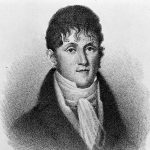
 Anyone who has been around very long knows what a fire hydrant is. Before the fire hydrant, water ad to be transported to a fire. If there was a water source nearby, they would often use a bucket brigade, but if not they had to try to bring it in by wagon. Bucket brigades weren’t very efficient, but they were all they had at the time. Firefighters stood in a line between the fire and the source of water and passed buckets along, one by one until the fire was extinguished. All too often, even in the cities, the structure burned to the ground because the source of water was simply too far away to save it. Finally, when city water became a thing, someone came up with the idea of a fire hydrant. This invention has worked so well, that it has saved untold numbers of lives and structures. These days there is a fire hydrant on just about every block. In fact, they are so common that we really don’t notice them at all.
Anyone who has been around very long knows what a fire hydrant is. Before the fire hydrant, water ad to be transported to a fire. If there was a water source nearby, they would often use a bucket brigade, but if not they had to try to bring it in by wagon. Bucket brigades weren’t very efficient, but they were all they had at the time. Firefighters stood in a line between the fire and the source of water and passed buckets along, one by one until the fire was extinguished. All too often, even in the cities, the structure burned to the ground because the source of water was simply too far away to save it. Finally, when city water became a thing, someone came up with the idea of a fire hydrant. This invention has worked so well, that it has saved untold numbers of lives and structures. These days there is a fire hydrant on just about every block. In fact, they are so common that we really don’t notice them at all.
Credit for the invention of the fire hydrant often goes to Frederick Graff Sr, who invented the first pillar fire hydrant in 1801, however fire hydrants were in place before that. The main reason that the credit has gone to Graff is that the name of the real inventor has been lost. We know that it was invented in Philadelphia, Pennsylvania in the early 1800s. That said, it must have been right before Graff’s version, which is said to have been invented in 1801. The patent with the name of the true inventor was destroyed, but just how that happened is unknown. There are stories of fire, floods, and even an argument that caused the destruction of them. Whatever happened, we will never really know the truth on this. However, we do know for a fact that Graff created the first pillar fire hydrant in 1801, which is the reason why he receives credit for it today.

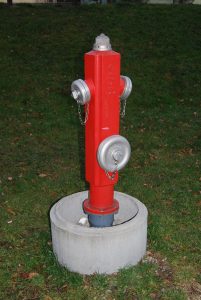
We owe a debt of gratitude to the inventor of the fire hydrant, whoever he may be, but we have no idea who to credit for it. I find it very strange that even the story of how the patent was lost is a mystery. It almost seems like it has been hidden for a specific purpose. It makes me wonder if the two men fought over who was the real inventor. Maybe they even worked on it together. Since both are now gone, we can’t even ask. The whole matter feels unreal, but we are left with the mystery anyway. Over the years styles and designs of hydrants have varied by country, state, and city, but the basic design is still the same. It pulls water from the underground source and connects it to the firefighters hose so water can be sprayed on the fire to put out the fire.
 These days, we all expect the latest new car to look different, to say the least, and strange, in some cases, but that is not really what we might have expected in the 1930s. Nevertheless, in 1933, they people might have been a little bit surprised to see the car designed by Richard Buckminster Fuller, an American architect, systems theorist, author, designer, inventor, and futurist. Fuller was born on July 12, 1895, in Milton, Massachusetts, the son of Richard Buckminster Fuller and Caroline Wolcott Andrews. The unusual middle name, Buckminster, was an ancestral family name. Like many kids, he tried numerous variations of his name. He used to sign his name differently each year in the guest register of his family summer vacation home at Bear Island, Maine. He finally settled on R. Buckminster Fuller. Not what I would have expected, but to each his own.
These days, we all expect the latest new car to look different, to say the least, and strange, in some cases, but that is not really what we might have expected in the 1930s. Nevertheless, in 1933, they people might have been a little bit surprised to see the car designed by Richard Buckminster Fuller, an American architect, systems theorist, author, designer, inventor, and futurist. Fuller was born on July 12, 1895, in Milton, Massachusetts, the son of Richard Buckminster Fuller and Caroline Wolcott Andrews. The unusual middle name, Buckminster, was an ancestral family name. Like many kids, he tried numerous variations of his name. He used to sign his name differently each year in the guest register of his family summer vacation home at Bear Island, Maine. He finally settled on R. Buckminster Fuller. Not what I would have expected, but to each his own.
Fuller married Ann Hewitt in 1917, and they would have two daughters, Alexandra born in 1918, and Allegra, born in 1927. Following the death of his daughter Alexandria in 1922 of complications from polio and spinal meningitis just before her fourth birthday, Fuller suffered with depression, even contemplating suicide. Then, he made a decision to live out his life as “an experiment to find what a single individual can contribute to changing the world and benefiting all humanity.”
In 1927, Fuller sketched the Dymaxion car under the name “4D transport.” The car was most unusual in its appearance. Part aircraft, part automobile, it actually had wings that inflated. Fuller asked a friend, sculptor, Isamu Noguchi to make more sketches of the car in 1932. The final design was an elongated teardrop body, with a rear third wheel that lifted off the ground and a tail fin. Fuller set up production of the Dymaxion car in a former Locomobile factory in Bridgeport in March 1933. The first model rolled out of the Bridgeport factory on July 12, 1933…Fuller’s 38th birthday. It had a steel chassis and a body made of ash wood, covered with an aluminum skin and topped with a painted canvas roof. It was designed to be able to reach a speed of 120 miles per hour and average 28 miles to the gallon of gasoline. The first model was sold to Gulf Oil, and dubbed the Dymaxion car. It went on display at the Century of Progress exposition in Chicago. Unfortunately, that October the professional driver Francis Turner was killed after the Dymaxion car turned over during a demonstration. The Dymaxion was cleared of responsibility in the ensuing investigation, but investors became scarce, despite the enthusiasm of the press and of celebrities such as the novelist H.G. Wells and the painter Diego Rivera.
The Dymaxion, along with the Nazi-built KdF-wagen (the forerunner of the Volkswagen Beetle), was one of several futuristic, rear-engined cars developed during the 1930s. Because of the tragic death of Francis Turner,  it was never mass-produced. Still, the Dymaxion helped lead to public acceptance of new streamlined passenger cars, such as the 1936 Lincoln Zephyr. The only surviving Dymaxion was featured in an exhibit dedicated to Fuller’s work at the Whitney Museum of American Art in New York City in 2008. The New York Times, in an article about the exhibit recalled Fuller’s own impressions of the Dymaxion, “‘I knew everyone would call it a car,’ he told the literary critic Hugh Kenner in the 1960s; instead, it was actually ‘the land-taxiing phase of a wingless, twin orientable jet stilts flying device.'” Interesting analogy…don’t you think?
it was never mass-produced. Still, the Dymaxion helped lead to public acceptance of new streamlined passenger cars, such as the 1936 Lincoln Zephyr. The only surviving Dymaxion was featured in an exhibit dedicated to Fuller’s work at the Whitney Museum of American Art in New York City in 2008. The New York Times, in an article about the exhibit recalled Fuller’s own impressions of the Dymaxion, “‘I knew everyone would call it a car,’ he told the literary critic Hugh Kenner in the 1960s; instead, it was actually ‘the land-taxiing phase of a wingless, twin orientable jet stilts flying device.'” Interesting analogy…don’t you think?
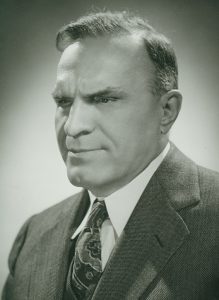 They say that “necessity is the mother of invention,” and never was that more true than for Ralph Teetor. The circumstances of his invention were of overwhelming necessity…to say the least. Teetor was blind, and because of that, he was forced to accept rides to wherever he chose to go. His friend, Harry Lindsay, who didn’t mind driving Teetor around, but who also had a notoriously “jerky accelerator foot.” Teetor couldn’t figure out why, Lindsay couldn’t keep the car at a consistent speed. When you think about it, a car that is being driven in a jerky manner would be a bit scary for a blind passenger, who has no idea why they might be possible stopping suddenly… or even if it just seems like they are stopping suddenly.
They say that “necessity is the mother of invention,” and never was that more true than for Ralph Teetor. The circumstances of his invention were of overwhelming necessity…to say the least. Teetor was blind, and because of that, he was forced to accept rides to wherever he chose to go. His friend, Harry Lindsay, who didn’t mind driving Teetor around, but who also had a notoriously “jerky accelerator foot.” Teetor couldn’t figure out why, Lindsay couldn’t keep the car at a consistent speed. When you think about it, a car that is being driven in a jerky manner would be a bit scary for a blind passenger, who has no idea why they might be possible stopping suddenly… or even if it just seems like they are stopping suddenly.
For Teetor, the possibility of things changing was impossible. He was not going to magically get his sight back, so something else had to change. Teetor was no stranger to the idea of inventing things. At the age of five, he endured a terrible accident, which 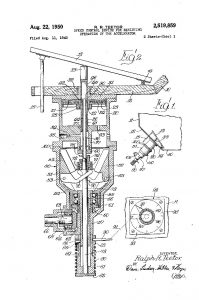 left him in his disabled condition. He was incredibly young age, but Teetor refused to allow an accident to keep him from living a full life. At age 12, he was featured in the December 21, 1902 edition of the New York Herald for building a one-cylinder car to scoot around in his neighborhood. Here is how the Herald described him in 1902: “A constructor of miniature dynamos and other machinery at 10 and thoroughly versed in all that pertains to their operation, and at 12 the builder of an automobile that carries him about the streets of his native town and far out upon the country roads at a speed of from 18 to 25 miles an hour, is the remarkable record of Ralph Teetor of Hagerstown, Indiana.”
left him in his disabled condition. He was incredibly young age, but Teetor refused to allow an accident to keep him from living a full life. At age 12, he was featured in the December 21, 1902 edition of the New York Herald for building a one-cylinder car to scoot around in his neighborhood. Here is how the Herald described him in 1902: “A constructor of miniature dynamos and other machinery at 10 and thoroughly versed in all that pertains to their operation, and at 12 the builder of an automobile that carries him about the streets of his native town and far out upon the country roads at a speed of from 18 to 25 miles an hour, is the remarkable record of Ralph Teetor of Hagerstown, Indiana.”
Teetor set out to solve his problem. He invented what we know today as the automobile cruise control system, which is an outer control loop that “takes over” control of the throttle…a task normally exercised by the driver through the accelerator pedal. Unlike the driver of the vehicle, the cruise control holds the vehicle speed steady at a set value. The invention worked perfectly on the first try, but being a perfectionist, Teetor spent the next decade tinkering with his design. By 1958, he had finally perfected his invention. Nevertheless, Cadillac began  rolling it out in all of their cars by 1950. The only part of his invention that Teetor ever struggled with was the name. At first, the invention was known by “a host of names more suited for the Wiley Coyote: Speedostat, Touchomatic, and Auto-pilot.” Eventually, the designers at Chrysler came up with “cruise control.” It wasn’t flashy, but it was also less likely to be mistaken for “a kitchen appliance.” Teetor decided that sacrifices just had to be made sometimes. So now you know that the cruise control…the gas-conserving savior of long-distance drivers everywhere, actually came from one man’s pet peeve. I would imagine that if you were blind, and being thrown around in your seat because you couldn’t drive yourself, you might be pretty grouchy, too.
rolling it out in all of their cars by 1950. The only part of his invention that Teetor ever struggled with was the name. At first, the invention was known by “a host of names more suited for the Wiley Coyote: Speedostat, Touchomatic, and Auto-pilot.” Eventually, the designers at Chrysler came up with “cruise control.” It wasn’t flashy, but it was also less likely to be mistaken for “a kitchen appliance.” Teetor decided that sacrifices just had to be made sometimes. So now you know that the cruise control…the gas-conserving savior of long-distance drivers everywhere, actually came from one man’s pet peeve. I would imagine that if you were blind, and being thrown around in your seat because you couldn’t drive yourself, you might be pretty grouchy, too.
 Author of Looking Backward:2000-1887, Edward Bellamy, wrote in the novel first published in 1888 novel, asked his readers to imagine a scene in which a time-traveler from 1887 reacts to a technological advance from the early 21st century that he describes as, “An arrangement for providing everybody with music in their homes, perfect in quality, unlimited in quantity, suited to every mood, and beginning and ceasing at will.” It’s amazing to me that many writers of fiction, see the future in a way most of us can’t. Their imaginations manage to picture a future that sometimes, proves to be uncannily like real life in the future. Jules Verne was that way too.
Author of Looking Backward:2000-1887, Edward Bellamy, wrote in the novel first published in 1888 novel, asked his readers to imagine a scene in which a time-traveler from 1887 reacts to a technological advance from the early 21st century that he describes as, “An arrangement for providing everybody with music in their homes, perfect in quality, unlimited in quantity, suited to every mood, and beginning and ceasing at will.” It’s amazing to me that many writers of fiction, see the future in a way most of us can’t. Their imaginations manage to picture a future that sometimes, proves to be uncannily like real life in the future. Jules Verne was that way too.
In Bellamy’s imagination…almost inventor-like, this astonishing feat would be accomplished by a vast network of wires connecting individual homes with centrally located concert halls staffed round-the-clock with live performers. Of course, that would be a difficult task to pull off, but in the end, someone else took care of the finer points of Bellamy’s vision. As we all know, today we can turn on a radio, whether plugged into the outlets in our home, or a portable version that we carry around, and of course, these days every smart phone has the ability to listen wirelessly to radio stations, watch television, and download all the music our hearts could desire.
Bellamy’s vision came to pass much sooner than the 2000 predicted date, and without all the wiring he thought would be needed, but he wasn’t too far off in what the end outcome would be…at least for the homes. I doubt it ever occurred to him that it could all be done wirelessly, or that telephones could have the same capability and much more. Of course, at that time, telephones were still in their very primitive stages. On October 1, 1920, Scientific American magazine reported that the rapidly developing medium of radio would soon be used to broadcast music. A revolution in the role of music in everyday life was about to be born.
“It has been well known for some years that by placing a form of telephone transmitter in a concert hall or at any point where music is being played the sound may be carried over telephone wires to an ordinary telephone receiver at a distant point,” began the bulletin in the October 1, 1920 issue of the popular science monthly, “but it is only recently that a method of transmitting music by radio has been found possible.”
People still argue about radio’s origins to this day, but its basic workings had been understood for upwards of 20 years at the time of this announcement. It was only in the years immediately following World War I, 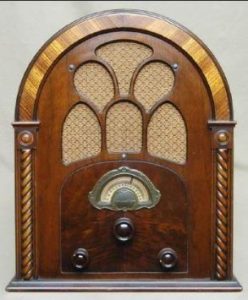 however, that radio made the transition from scientific curiosity to practical technology. Then, by late 1919, Britain, the United States and elsewhere were beginning experiments that would lead to the breakthrough use of radio not just as a replacement for the telegraph, but as a communications and entertainment medium. The idea that Bellamy suggested, was coming to pass…a full 81 years sooner than he had expected.
however, that radio made the transition from scientific curiosity to practical technology. Then, by late 1919, Britain, the United States and elsewhere were beginning experiments that would lead to the breakthrough use of radio not just as a replacement for the telegraph, but as a communications and entertainment medium. The idea that Bellamy suggested, was coming to pass…a full 81 years sooner than he had expected.
It was those experiments that led to the public announcement in Scientific American. “Music can be performed at any place, radiated into the air through an ordinary radio transmitting set and received at any other place, even though hundreds of miles away,” the report continued, noting that “the music received can be made as loud as desired by suitable operation of the receiving apparatus.” “Experimental concerts are at present being conducted every Friday evening from 8:30 to 11:00 by the Radio Laboratory of the Bureau of Standard. The possibilities of such centralized radio concerts are great and extremely interesting.” Bellamy’s dream had come to pass.
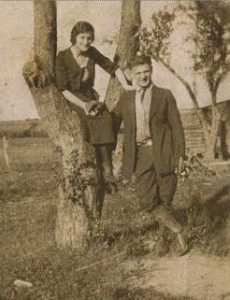 Every family struggles to find ways to do things together…not to mention the time to do so. Kids have their own activities, such as sports, dance, and other club and school activities. Parents work, kids have school, and then there are things that need to be done around the house. By the time dinner is cooked and eaten, and the table cleared, who feels like doing more activities. Plus, there is homework to be done. It seems like there isn’t time for anything more than a television show before bed.
Every family struggles to find ways to do things together…not to mention the time to do so. Kids have their own activities, such as sports, dance, and other club and school activities. Parents work, kids have school, and then there are things that need to be done around the house. By the time dinner is cooked and eaten, and the table cleared, who feels like doing more activities. Plus, there is homework to be done. It seems like there isn’t time for anything more than a television show before bed.
Most of us think this is just something that has come with modern day families, where they barely have time to eat dinner together…if that. In reality, it is a problem that has been around for a lot longer. Kids just naturally grow up and become more independent, and parents get busier too. Something had to be done, so in 1939, so Charles Steinlauf stepped up. He didn’t build his bicycle for a record, because there wasn’t such a thing then. The Guinness book of records didn’t begin until the early 1950’s. Nevertheless, he was some “inventor” to use the word lightly. His was an interesting bicycle, and apparently it held something for everyone…I guess. As odd as it was, the bicycle really  did work. The top rider, namely Charles steered the bicycle with an automobile steering wheel. His wife sat below operating a sewing machine. Their son was in back and their daughter sat on handle bars in front. When they stopped, the legs of the sewing machine kept the two story Goofybike, as it was called, from falling over. I don’t know any other way to safely stop it.
did work. The top rider, namely Charles steered the bicycle with an automobile steering wheel. His wife sat below operating a sewing machine. Their son was in back and their daughter sat on handle bars in front. When they stopped, the legs of the sewing machine kept the two story Goofybike, as it was called, from falling over. I don’t know any other way to safely stop it.
It might have been one of the strangest inventions in history, but, it did get his family out and about in Chicago, Illinois, and I’m certain it also brought them quite a bit of notoriety. I’m sure that there were lots of people who that of Steinlauf as that “weird inventor,” and to be honest, it looks like he just hooked a bunch of odds and ends together. It was, however, a little more technical than that, after all, just hooking a bunch of things together, does not a bicycle make. It has to be able to be ridden in order to really qualify as a bicycle, weird or not. And the Goofybike could be and was ridden by the whole Steinlauf family.
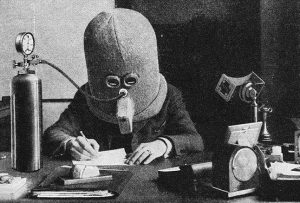 I think we have all had times when we couldn’t seem to concentrate on our work. Or maybe you had a child who couldn’t concentrate on their homework. Well, in 1925, an inventor named Hugo Gernsback, a Luxembourgish-American inventor, writer, editor, and magazine publisher, invented a helmet to make sure a person focused on their work. It was called the Isolator, and it was…well, bizarre. Gernsback was often known as “The Father Of Science Fiction,” and one look at his invention can tell you why that might be. The Isolator was a wooden helmet that blocked out sound and vision in order to help the wearer focus on whatever task was at hand. Gernsback claimed that the helmet blocked out sound by up to 95%, and the tiny glass spy-hole ensured that no amount of movement nearby could be seen, so that the wearer was not distracted. This would eliminate all outside distractions, and barely give enough room for the wearer to see the work in front of them, and nothing else.
I think we have all had times when we couldn’t seem to concentrate on our work. Or maybe you had a child who couldn’t concentrate on their homework. Well, in 1925, an inventor named Hugo Gernsback, a Luxembourgish-American inventor, writer, editor, and magazine publisher, invented a helmet to make sure a person focused on their work. It was called the Isolator, and it was…well, bizarre. Gernsback was often known as “The Father Of Science Fiction,” and one look at his invention can tell you why that might be. The Isolator was a wooden helmet that blocked out sound and vision in order to help the wearer focus on whatever task was at hand. Gernsback claimed that the helmet blocked out sound by up to 95%, and the tiny glass spy-hole ensured that no amount of movement nearby could be seen, so that the wearer was not distracted. This would eliminate all outside distractions, and barely give enough room for the wearer to see the work in front of them, and nothing else.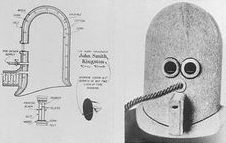
While it might have been a great device to help the wearer focus, it looked more like some kind of medieval torture device. The front of the device had an oxygen tube that was attached to a bottle of oxygen, so it was impossible to eat and study too. So, with no sound, no food, no way to play video games, the modern child would have no choice but to focus on homework. Now, I don’t know if the device could be locked in place…only to be removed when the work at hand was done, but if that is the case, I would think the wearer would get right to the task, so that the device could come off sooner. Just think of how much studying a college student could accomplish. Of course, my guess would be that even a person who was not claustrophobic before wearing the Isolator, would be claustrophobic after wearing it…not to mention a little paranoid, and leery of the person  who made them wear the Isolator in the first place.
who made them wear the Isolator in the first place.
The Isolator never really caught on, and I think anyone can see why that might be, but I guess it might have been a good idea, had it not been so archaic and confining. Of course, that was only part of the problem. The wearer also looked ridiculous, and while they could be anonymously ridiculous looking in some places, it didn’t work that way at the office or in study hall, where everyone knew who was in the office or class. And, of course, it would be really creepy sitting next to someone who was wearing the Isolator. I think we will have to chalk this one up to a good idea gone crazy.
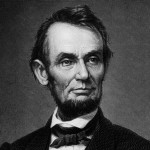 Hot air balloons have been around for a long time, and there have been multiple uses for them. Hot air balloons have been used for everything from travel, recreation, escape, war, and even spying. It was the latter reason that brought President Abraham Lincoln to a field outside Washington DC on October 4, 1861. Those were tumultuous years, with the Civil War in full swing, and both the Confederate and the Union armies were experimenting with the idea of using hot air balloons to gather military intelligence. It was probably a good idea, but there was enough danger involved with this idea, that it proved to be impractical in most situations.
Hot air balloons have been around for a long time, and there have been multiple uses for them. Hot air balloons have been used for everything from travel, recreation, escape, war, and even spying. It was the latter reason that brought President Abraham Lincoln to a field outside Washington DC on October 4, 1861. Those were tumultuous years, with the Civil War in full swing, and both the Confederate and the Union armies were experimenting with the idea of using hot air balloons to gather military intelligence. It was probably a good idea, but there was enough danger involved with this idea, that it proved to be impractical in most situations.
I don’t think most people who were presented with the idea of using hot air balloons in a war situation, were very sold on it. Several firms had been talking to the War Department about balloons, but Thaddeus SC Lowe, who had been working with hydrogen balloons for several 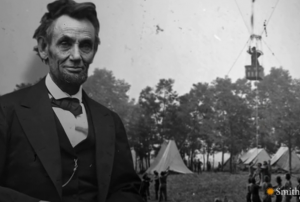 years, and was convinced that they could be a useful tool for collecting intelligence, was the primary figure in that quest. He had conducted trials in April 1861 near Cincinnati, Ohio, with the support of the Smithsonian Institution. On April 19, 1861, he took flight for a trip that would take him to Unionville, South Carolina, where he was immediately jailed by the Confederates, who were convinced that he was a Union spy.
years, and was convinced that they could be a useful tool for collecting intelligence, was the primary figure in that quest. He had conducted trials in April 1861 near Cincinnati, Ohio, with the support of the Smithsonian Institution. On April 19, 1861, he took flight for a trip that would take him to Unionville, South Carolina, where he was immediately jailed by the Confederates, who were convinced that he was a Union spy.
In the end, Lowe had it right. The hot air balloon could be instrumental in winning a war. He became the head of the Union’s Balloon Corpsin 1861 and served effectively during the Peninsular campaign of 1862. With the views provided from his balloon, Lowe discovered that the Confederates had evacuated Yorktown, Virginia, and 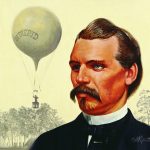 he provided important intelligence during the Battle of Fair Oaks, Virginia. He had a good working relationship with George McClellan, commander of the Army of the Potomac, but had difficulties with McClellan’s successors. Generals Ambrose Burnside and Joseph Hooker were sadly not convinced that balloon observations provided accurate information. I guess they just didn’t have the same vision as Lowe had. Lowe became increasingly frustrated with the army, particularly after his pay was slashed in 1863. Feeling that army commanders did not take his service seriously, Lowe resigned in the spring of 1863. The Balloon Corps was disbanded in August of that year. Lowe later became involved in building a railway in California. He died there in 1913 at age 80.
he provided important intelligence during the Battle of Fair Oaks, Virginia. He had a good working relationship with George McClellan, commander of the Army of the Potomac, but had difficulties with McClellan’s successors. Generals Ambrose Burnside and Joseph Hooker were sadly not convinced that balloon observations provided accurate information. I guess they just didn’t have the same vision as Lowe had. Lowe became increasingly frustrated with the army, particularly after his pay was slashed in 1863. Feeling that army commanders did not take his service seriously, Lowe resigned in the spring of 1863. The Balloon Corps was disbanded in August of that year. Lowe later became involved in building a railway in California. He died there in 1913 at age 80.

